Transdermal Adhesives Market
Transdermal Adhesives Market Size and Share Forecast Outlook 2025 to 2035
Transdermal adhesives market is projected to grow from USD 2.2 billion in 2025 to USD 3.6 billion by 2035, at a CAGR of 5.3%. Acrylic will dominate with a 50.0% market share, while drug delivery patches will lead the application segment with a 65.0% share.
Transdermal Adhesives Market Forecast and Outlook 2025 to 2035
The global transdermal adhesives market is projected to grow from USD 2,150.0 million in 2025 to approximately USD 3,600.0 million by 2035, recording an absolute increase of USD 1,450.0 million over the forecast period. This translates into a total growth of 67.4%, with the market forecast to expand at a compound annual growth rate (CAGR) of 5.3% between 2025 and 2035.
The overall market size is expected to grow by nearly 1.7X during the same period, supported by expanding medical device applications, growing adoption in drug delivery systems, and rising demand for patient-friendly pharmaceutical solutions across various therapeutic and consumer health applications.
Quick Stats for Transdermal Adhesives Market
- Transdermal Adhesives Market Value (2025): USD 2,150.0 million
- Transdermal Adhesives Market Forecast Value (2035): USD 3,600.0 million
- Transdermal Adhesives Market CAGR: 5.3%
- Leading Segment by Type (2025): Acrylic (50.0%)
- Leading Segment by Application (2025): Drug Delivery Patches (65.0%)
- Leading Segment by Form (2025): Matrix (70.0%)
- Key Growth Regions: Asia Pacific, North America, and Europe
- Top Companies by Market Share: 3M, LTS Lohmann, Smith & Nephew
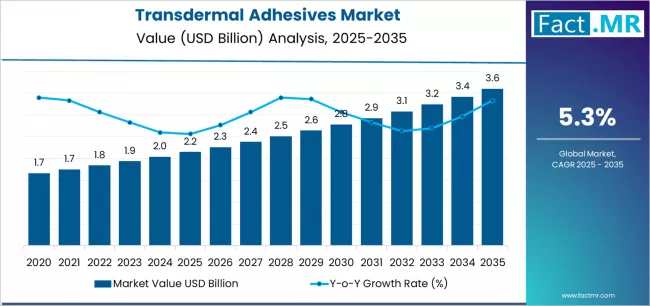
Production operations experience substantial difficulties when managing adhesive coating uniformity across large-scale web coating lines, as even minor variations in coating thickness can affect drug permeation rates beyond acceptable pharmaceutical specifications. Manufacturing supervisors regularly encounter equipment calibration conflicts when transitioning between different adhesive formulations, as cross-contamination prevention protocols require extensive cleaning validation that can extend changeover times to multiple shifts. These operational constraints create scheduling tensions between production planning teams seeking maximum throughput and regulatory compliance teams demanding comprehensive documentation for each process parameter adjustment.
Supply chain dynamics reveal critical dependencies on specialized silicone release liner materials that require precise surface energy specifications for consistent adhesive transfer properties. Procurement teams face ongoing supplier qualification challenges as FDA requirements for transdermal patch components demand extensive documentation of raw material manufacturing processes and facility inspections. Converting operations encounter persistent technical issues with die-cutting precision when processing multi-layer adhesive constructions, as blade wear affects edge quality and can create micro-defects that compromise patch integrity during patient application.
Environmental control systems present ongoing operational challenges as humidity fluctuations during coating operations can affect adhesive crosslinking chemistry and drug stability profiles. Maintenance departments struggle with adhesive residue management on coating equipment, as specialized cleaning solvents required for pharmaceutical-grade cleanliness create waste disposal compliance issues and increase operational costs. Production teams experience frequent delays when environmental monitoring systems detect contamination events, as investigation protocols can halt production lines for extended periods while root cause analysis procedures are completed.
Drug delivery system development creates complex technical requirements as pharmaceutical companies demand adhesive solutions that maintain consistent drug release profiles across varying skin conditions and patient demographics. Engineering teams encounter conflicting performance requirements when optimizing adhesive formulations for extended wear applications, as skin compatibility demands conflict with secure attachment requirements during physical activity. These formulation challenges necessitate extensive clinical testing protocols that extend product development timelines and create resource allocation conflicts between research and development budgets and manufacturing capacity investments.
Transdermal Adhesives Market Key Takeaways
| Metric | Value |
|---|---|
| Market Value (2025) | USD 2,150.0 million |
| Market Forecast Value (2035) | USD 3,600.0 million |
| Forecast CAGR (2025-2035) | 5.3% |
Why is the Transdermal Adhesives Market Growing?
| MEDICAL DEVICE TRENDS | MANUFACTURING REQUIREMENTS | REGULATORY & QUALITY STANDARDS |
|---|---|---|
| Advanced Drug Delivery Systems Growing adoption of transdermal drug delivery systems across pharmaceutical applications driving demand for specialized adhesive solutions that provide controlled release and patient comfort. Aging Population Demographics Increasing focus on patient-friendly pharmaceutical delivery systems and non-invasive treatment options creating demand for advanced adhesive technologies in medical applications. Premium Medical Performance Superior skin adhesion properties and biocompatibility characteristics making transdermal adhesives essential for performance-focused medical device applications and patient care solutions. | High-Performance Adhesion Requirements Modern medical device manufacturing requires high-performance adhesive materials delivering precise adhesion control and enhanced biocompatibility properties. Processing Efficiency Demands Medical device manufacturers investing in premium adhesive materials offering consistent performance while maintaining processing efficiency across diverse applications. Quality and Reliability Standards Certified producers with proven track records required for advanced medical adhesive applications across pharmaceutical and healthcare sectors. | Medical Device Standards Regulatory requirements establishing performance benchmarks favoring high-quality medical adhesive materials meeting stringent safety criteria. Performance Property Standards Quality standards requiring superior adhesion properties and resistance to environmental stresses in medical processing environments. Industrial Compliance Requirements Diverse medical requirements and quality standards driving need for sophisticated adhesive material solutions throughout healthcare applications. |
Transdermal Adhesives Market Segmentation
| Category | Segments Covered |
|---|---|
| By Type | Acrylic, Silicone, Polyisobutylene |
| By Application | Drug Delivery Patches, OTC/Nutraceutical Patches, Cosmetic Patches |
| By Form | Matrix, Reservoir |
| By Region | North America, Europe, Asia Pacific, Latin America, Middle East & Africa |
Transdermal Adhesives Market Analysis by Type
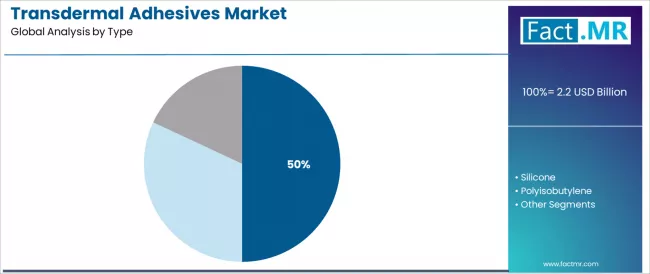
| Segment | 2025 to 2035 Outlook |
|---|---|
| Acrylic | Leader in 2025 with 50.0% market share; likely to maintain leadership through 2035. Broadest use across drug delivery, OTC, and cosmetic applications, mature supply chain, predictable functionality. Momentum: steady-to-strong across medical applications. Watchouts: raw material price volatility. |
| Silicone | Premium segment with 30.0% market share focused on sensitive skin applications and long-wear patches. Superior biocompatibility and gentle removal properties supporting specialized medical uses. Momentum: rising in premium applications. Watchouts: higher cost structures. |
| Polyisobutylene | Cost-effective segment with 20.0% market share serving standard medical and consumer applications. Established performance in traditional patch systems with reliable adhesion characteristics. Momentum: steady in traditional applications; flat to slightly up in premium segments. |
Transdermal Adhesives Market Analysis by Application
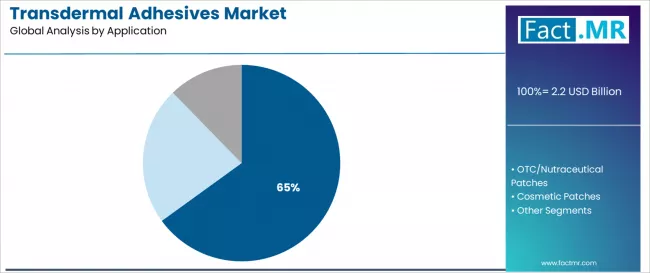
| Segment | 2025 to 2035 Outlook |
|---|---|
| Drug Delivery Patches | At 65.0%, largest application segment in 2025 with established pharmaceutical integration. Mature supply chains, standardized processing specifications across prescription medications. Momentum: steady growth driven by aging demographics and chronic disease management. Watchouts: regulatory changes affecting formulation requirements. |
| OTC/Nutraceutical Patches | Growing segment with 20.0% share driven by consumer health trends and self-medication demand. Acrylic and silicone adhesives dominate applications. Momentum: strong growth through 2030, supported by wellness awareness. Watchouts: competition from alternative delivery methods. |
| Cosmetic Patches | Specialized segment with 15.0% share serving beauty and personal care applications. Growing demand for cosmetic delivery systems supporting higher-value beauty applications. Momentum: moderate growth via functional cosmetics expansion. Watchouts: regulatory requirements affecting cosmetic processing. |
Transdermal Adhesives Market Analysis by Form
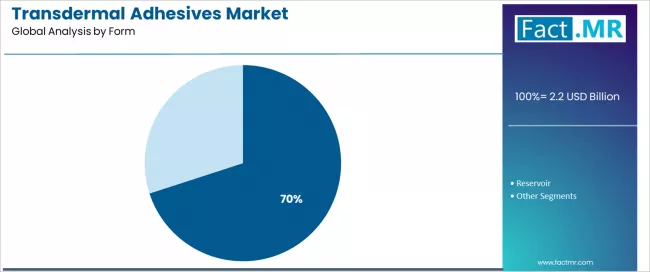
| Form | Status & Outlook 2025-2035 |
|---|---|
| Matrix | Dominant form in 2025 with 70.0% share for medical and consumer applications. Drug-in-adhesive systems, processing advantages, ease of manufacturing. Momentum: steady growth driven by manufacturing efficiency and processing advantages. Watchouts: formulation complexity in certain applications. |
| Reservoir | Important for specialized applications requiring precise drug control with 30.0% share. Value-add through controlled release properties, custom formulations, specialized processing. Momentum: moderate growth as specialty applications demand enhanced control properties. Processing complexity may limit broader growth. |
DRIVERS
| DRIVERS | RESTRAINTS | KEY TRENDS |
|---|---|---|
| Medical Device Growth Continuing expansion of medical device applications and pharmaceutical delivery systems across established and emerging markets driving demand for high-performance adhesive solutions throughout medical applications. Aging Population Demographics Increasing adoption of transdermal delivery systems and patient-friendly treatment options driving importance in pharmaceutical efficiency and biocompatibility optimization. Premium Medical Demand Growing demand for medical adhesives that support both performance benefits and processing efficiency in pharmaceutical manufacturing and healthcare applications. | Raw Material Price Volatility Price fluctuations affecting production costs and supply chain predictability for manufacturers across diverse adhesive material segments. Manufacturing Complexity Complex technical requirements across applications affecting product development and standardization throughout medical device manufacturing. Technical Qualification Requirements Strict qualification and validation needs impacting approval timelines and scalability of new adhesive materials. Competition from Alternatives Alternative delivery technologies affecting market selection and development across medical device applications. | Advanced Processing Technologies Integration of advanced adhesive processing systems, manufacturing innovations, and quality control solutions enabling superior operational efficiency. Performance Enhancement Enhanced adhesion control, improved skin compatibility, and advanced biocompatibility capabilities compared to traditional adhesive systems. Specialized Formulations Development of specialized adhesive grades and custom formulations providing enhanced performance benefits and application-specific optimization. Technical Innovation Integration of advanced adhesive development and intelligent processing management for sophisticated medical solutions. |
Analysis of Transdermal Adhesives Market by Key Countries
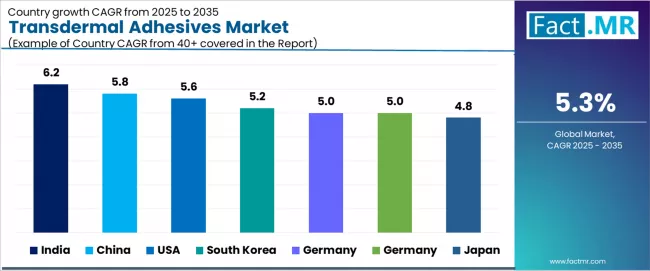
| Country | CAGR (2025-2035) |
|---|---|
| India | 6.2% |
| China | 5.8% |
| USA | 5.6% |
| South Korea | 5.2% |
| Germany | 5.0% |
| Japan | 4.8% |
| Brazil | 5.0% |
India Leads Global Market Growth with Medical Device Excellence
Revenue from transdermal adhesives in India is projected to exhibit strong growth driven by expanding healthcare infrastructure and comprehensive pharmaceutical innovation creating substantial opportunities for adhesive suppliers across medical device operations, pharmaceutical applications, and specialty healthcare sectors.
The country's developing medical manufacturing tradition and expanding healthcare awareness capabilities are creating significant demand for both conventional and high-performance adhesive materials. Major pharmaceutical companies are establishing comprehensive local adhesive processing facilities to support large-scale manufacturing operations and meet growing demand for efficient medical solutions.
Healthcare industry modernization programs are supporting widespread adoption of advanced adhesive processing across manufacturing operations, driving demand for high-quality medical materials.
Pharmaceutical processing excellence initiatives and specialized drug delivery development are creating substantial opportunities for adhesive suppliers requiring reliable performance and cost-effective medical solutions. Medical device manufacturing growth and pharmaceutical processing development are facilitating adoption of specialty adhesive materials throughout major industrial regions.
China Demonstrates Strong Market Potential with Medical Manufacturing Growth
Revenue from transdermal adhesives in China is expanding supported by extensive pharmaceutical manufacturing expansion and comprehensive medical device industry development creating demand for reliable adhesive materials across diverse manufacturing categories and specialty medical segments. The country's dominant pharmaceutical production position and expanding medical manufacturing capabilities are driving demand for adhesive solutions that provide consistent performance while supporting cost-effective processing requirements. Medical processors and manufacturers are investing in local production facilities to support growing manufacturing operations and pharmaceutical demand.
Pharmaceutical manufacturing operations expansion and medical processing capability development are creating opportunities for adhesive materials across diverse manufacturing segments requiring reliable performance and competitive processing costs. Manufacturing modernization and processing technology advancement are driving investments in medical supply chains supporting performance requirements throughout major industrial regions. Medical manufacturing growth and specialty pharmaceutical development programs are enhancing demand for processing-grade adhesives throughout medical production areas.
USA Maintains Strong Position with Premium Medical Innovation
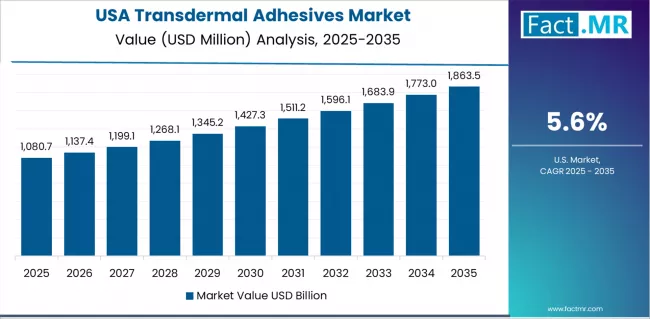
Demand for transdermal adhesives in USA is projected to grow supported by the country's expanding medical device manufacturing base and pharmaceutical processing technologies requiring advanced adhesive systems for drug delivery and medical device applications. American medical companies are implementing processing systems that support advanced manufacturing techniques, operational efficiency, and comprehensive quality protocols. The market is characterized by focus on operational excellence, medical performance, and compliance with FDA quality standards.
Premium medical industry investments are prioritizing advanced processing technologies that demonstrate superior biocompatibility and quality while meeting American manufacturing standards. Medical processing leadership programs and operational excellence initiatives are driving adoption of precision-engineered adhesive materials that support advanced manufacturing systems and performance optimization. Research and development programs for biocompatibility enhancement are facilitating adoption of specialized processing techniques throughout major medical centers.
South Korea Focuses on Advanced Medical Manufacturing
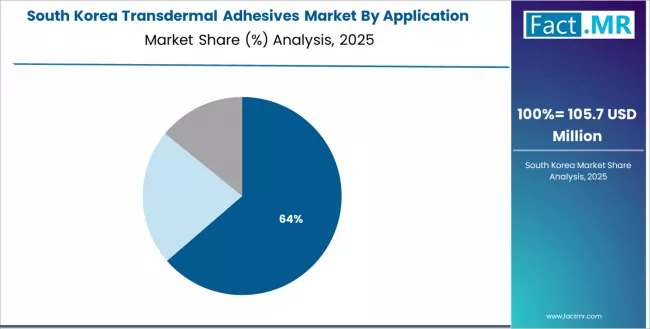
Demand for transdermal adhesives in South Korea is projected to grow at 5.2% CAGR driven by advanced medical manufacturing excellence and specialty adhesive capabilities supporting pharmaceutical development and comprehensive medical applications. The country's established medical processing tradition and growing performance healthcare market segments are creating demand for high-quality adhesive materials that support operational performance and medical standards.
Advanced medical manufacturing and specialty adhesive programs are supporting demand for processing-grade transdermal adhesives that meet contemporary performance and reliability standards. Pharmaceutical development and performance-focused manufacturing programs are creating opportunities for specialized adhesive materials that provide comprehensive medical support. Manufacturing modernization and medical quality enhancement programs are facilitating adoption of advanced processing capabilities throughout major healthcare regions.
Germany Focuses on Premium Medical Manufacturing
Demand for transdermal adhesives in Germany is projected to grow driven by premium medical manufacturing excellence and specialty adhesive capabilities supporting advanced pharmaceutical development and comprehensive medical device applications. The country's established medical processing tradition and growing performance healthcare market segments are creating demand for high-quality adhesive materials that support operational performance and medical standards. Medical manufacturers and processing suppliers are maintaining comprehensive development capabilities to support diverse manufacturing requirements.
Premium medical manufacturing and specialty adhesive programs are supporting demand for processing-grade transdermal adhesives that meet contemporary performance and reliability standards. Medical device development and performance-focused manufacturing programs are creating opportunities for specialized adhesive materials that provide comprehensive healthcare support. Manufacturing modernization and medical quality enhancement programs are facilitating adoption of advanced processing capabilities throughout major medical regions.
Japan Focuses on Precision Medical Manufacturing
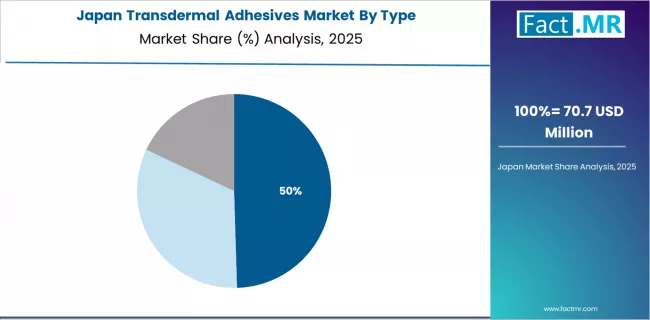
Demand for transdermal adhesives in Japan is projected to grow driven by precision medical manufacturing excellence and specialty adhesive capabilities supporting advanced pharmaceutical development and comprehensive technical applications. The country's established medical processing tradition and growing performance healthcare market segments are creating demand for high-quality adhesive materials that support operational performance and medical standards.
Precision medical manufacturing and specialty adhesive programs are supporting demand for processing-grade transdermal adhesives that meet contemporary performance and reliability standards. Pharmaceutical development and performance-focused manufacturing programs are creating opportunities for specialized adhesive materials that provide comprehensive medical support. Manufacturing modernization and medical quality enhancement programs are facilitating adoption of advanced processing capabilities throughout major healthcare regions.
Brazil Focuses on Healthcare Access Enhancement
Demand for transdermal adhesives in Brazil is projected to grow at 5.0% CAGR driven by healthcare accessibility improvements and medical manufacturing development programs creating opportunities for adhesive suppliers serving pharmaceutical operations and medical device contractors. The country's expanding healthcare base and growing medical awareness are creating demand for adhesive materials that support diverse performance requirements while maintaining processing performance standards.
Healthcare development programs and adhesive manufacturing are facilitating adoption of transdermal adhesive materials capable of supporting diverse medical requirements and competitive processing standards. Medical manufacturing innovation and performance-focused development programs are enhancing demand for processing-grade adhesives that support operational efficiency and performance reliability. Healthcare market expansion and specialty medical development are creating opportunities for advanced adhesive processing capabilities across Brazilian medical manufacturing facilities.
Europe Market Split by Processing Application
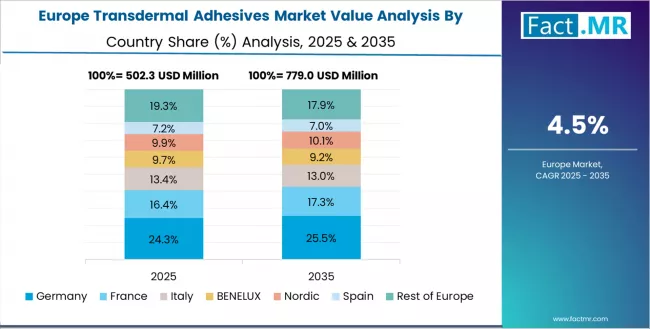
European transdermal adhesives operations are increasingly polarized between Western European precision processing and Eastern European cost-competitive manufacturing. German (USD 480.0 million) and UK facilities (USD 350.0 million) dominate premium medical device and pharmaceutical adhesive processing, leveraging advanced medical technologies and strict quality protocols that command price premiums in global markets. German processors maintain leadership in high-performance medical adhesive applications, with major pharmaceutical companies driving technical specifications that smaller suppliers must meet to access supply contracts.
France (USD 300.0 million), Italy (USD 230.0 million), and Spain (USD 190.0 million) operations focus on specialized applications and regional market requirements. Rest of Europe (USD 600.0 million) including Eastern European operations in Poland, Hungary, and Czech Republic are capturing volume-oriented processing contracts through labor cost advantages and EU regulatory compliance, particularly in standard adhesive materials for medical device applications.
The regulatory environment presents both opportunities and constraints. EU Medical Device Regulation and pharmaceutical directives create barriers for novel adhesive materials but establish quality standards that favor established European processors over imports. Brexit has fragmented UK sourcing from EU suppliers, creating opportunities for direct relationships between processors and British medical manufacturers.
Supply chain consolidation accelerates as processors seek economies of scale to absorb rising energy costs and compliance expenses. Vertical integration increases, with major pharmaceutical manufacturers acquiring processing facilities to secure adhesive supplies and quality control. Smaller processors face pressure to specialize in niche applications or risk displacement by larger, more efficient operations serving mainstream medical device manufacturing requirements.
Premium Quality Standards Define Japanese Market Dynamics
Japanese Transdermal Adhesives operations reflect the country's exacting quality standards and sophisticated medical expectations. Major pharmaceutical manufacturers maintain rigorous supplier qualification processes that often exceed international standards, requiring extensive documentation, batch testing, and facility audits that can take 12-18 months to complete. This creates high barriers for new suppliers but ensures consistent quality that supports premium product positioning.
The Japanese market demonstrates unique application preferences with Drug Delivery Patches accounting for 70.0%, OTC/Nutraceutical Patches 20.0%, and Cosmetic Patches 10.0%. Companies require specific adhesion specifications and biocompatibility requirements that differ from Western applications, driving demand for customized processing capabilities.
Japanese market demonstrates unique type preferences with Acrylic accounting for 60.0%, Silicone 25.0%, and Polyisobutylene 15.0%. Companies require specific molecular binding and biocompatibility specifications that differ from Western applications, driving demand for customized adhesive capabilities.
Regulatory oversight emphasizes comprehensive medical material management and traceability requirements that surpass most international standards. The medical device registration system requires detailed material sourcing information, creating advantages for suppliers with transparent supply chains and comprehensive documentation systems.
Supply chain management focuses on relationship-based partnerships rather than purely transactional procurement. Japanese companies typically maintain long-term supplier relationships spanning decades, with annual contract negotiations emphasizing quality consistency over price competition. This stability supports investment in specialized processing equipment tailored to Japanese specifications.
Market Dynamics Drive Innovation in South Korea
South Korean transdermal adhesives operations reflect the country's advanced medical manufacturing sector and export-oriented business model. Major pharmaceutical companies drive sophisticated material procurement strategies, establishing direct relationships with global suppliers to secure consistent quality and pricing for their medical device and pharmaceutical operations targeting both domestic and international markets.
The Korean market demonstrates strength in type distribution with Acrylic accounting for 60.0%, Silicone 25.0%, and Polyisobutylene 15.0%. This performance-focused approach creates demand for specific biocompatibility specifications that differ from Western applications, requiring suppliers to adapt adhesive formulation and purification techniques.
Regulatory frameworks emphasize medical material safety and traceability, with Korean medical administration standards often exceeding international requirements. This creates barriers for smaller medical suppliers but benefits established processors who can demonstrate compliance capabilities. The regulatory environment particularly favors suppliers with comprehensive certification and documentation systems.
Supply chain efficiency remains critical given Korea's geographic limitations and import dependence. Companies increasingly pursue long-term contracts with suppliers in United States, Germany, and Japan to ensure reliable access to raw materials while managing foreign exchange risks. Technical logistics investments support quality preservation during extended shipping periods.
The market faces pressure from rising labor costs and competition from lower-cost regional manufacturers, driving automation investments and consolidation among smaller processors. The premium positioning of Korean medical brands internationally continues to support demand for high-quality adhesive materials that meet stringent specifications.
Competitive Landscape of the Transdermal Adhesives Market
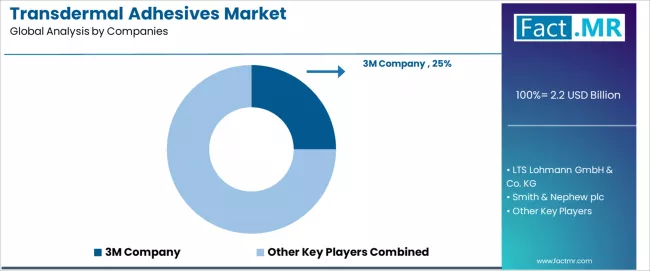
The transdermal adhesives market is witnessing a strategic shift as profit pools increasingly concentrate both upstream in high-capacity adhesive manufacturing and downstream in niche, value-added segments such as medical devices, pharmaceutical patches, and consumer healthcare products. Premiumization is driving this evolution, with customers prioritizing adhesives that meet stringent regulatory requirements, demonstrate consistent performance, and provide traceability throughout the supply chain.
Market value is progressively moving away from generic adhesive commodities toward highly engineered, application-specific solutions, where formulation expertise, biocompatibility assurance, and quality control establish competitive differentiation. Key market players follow distinct strategies: global medical integrators leverage scale and reliability to maintain market dominance; multi-grade processors address complex production needs and a broad spectrum of applications; specialized adhesive developers exploit formulation know-how and close partnerships with device manufacturers; and performance-oriented suppliers capture high-volume opportunities in advanced pharmaceutical and healthcare applications.
High switching costs, including re-qualification, biocompatibility validation, and clinical testing, favor incumbent suppliers, yet evolving regulatory standards and intermittent supply disruptions create openings for agile and diversified players. Ongoing consolidation and vertical integration are complemented by digital procurement channels in commodity-grade adhesives, while premium-grade solutions remain relationship-driven.
Strategic imperatives for market participants include securing medical and pharmaceutical supply pipelines through application-specific adhesive grades and robust service agreements, expanding multi-grade production capabilities with transparent technical documentation, and innovating specialized adhesive formulations that meet evolving biocompatibility and regulatory demands.
| Stakeholder Type | Primary Advantage | Repeatable Plays |
|---|---|---|
| Global medical integrators | Scale, production integration, technical reliability | Long-term contracts, tight specs, co-development with medical/pharmaceutical |
| Multi-grade processors | Grade diversification, application expertise, supply flexibility | Multi-application serving, technical support, quality assurance across segments |
| Specialty adhesive developers | Formulation expertise and industry relationships | Custom grades, biocompatibility science, performance SLAs |
| Performance suppliers | Application-focused demand and specialized service | Technical performance claims, specialized grades, application activation |
| Medical distributors & platforms | Technical support for mid-tier manufacturers | Grade selection, smaller volumes, technical service |
Key Players in the Transdermal Adhesives Market
- 3M Company
- LTS Lohmann GmbH & Co. KG
- Smith & Nephew plc
- Henkel AG & Co. KGaA
- Avery Dennison Corporation
- Nitto Denko Corporation
- Scapa Group plc
- BASF SE
- Johnson & Johnson
- Adhesives Research, Inc.
- Coloplast A/S
- Solvay S.A.
- H.B. Fuller Company
- Cardinal Health, Inc.
Scope of the Report
| Items | Values |
|---|---|
| Quantitative Units (2025) | USD 2,150.0 Million |
| Type | Acrylic, Silicone, Polyisobutylene |
| Application | Drug Delivery Patches, OTC/Nutraceutical Patches, Cosmetic Patches |
| Form | Matrix, Reservoir |
| Regions Covered | North America, Europe, Asia Pacific, Latin America, Middle East & Africa |
| Countries Covered | United States, Germany, China, Japan, India, South Korea, Brazil, and other 40+ countries |
| Key Companies Profiled | 3M, LTS Lohmann, Smith & Nephew, Henkel, Avery Dennison, Nitto Denko, Scapa, BASF, Johnson & Johnson, Adhesives Research, Coloplast, Solvay, H.B. Fuller, Cardinal Health |
| Additional Attributes | Dollar sales by product/application/form, regional demand (NA, EU, APAC), competitive landscape, matrix vs. reservoir adoption, production/processing integration, and advanced processing innovations driving biocompatibility enhancement, technical advancement, and efficiency |
Transdermal Adhesives Market Segmentation
-
By Type :
- Acrylic
- Silicone
- Polyisobutylene
-
By Application :
- Drug Delivery Patches
- OTC/Nutraceutical Patches
- Cosmetic Patches
-
By Form :
- Matrix
- Reservoir
-
By Region :
- North America
- Europe
- Asia Pacific
- Latin America
- Middle East & Africa
Table of Content
- Executive Summary
- Global Market Outlook
- Demand to side Trends
- Supply to side Trends
- Technology Roadmap Analysis
- Analysis and Recommendations
- Market Overview
- Market Coverage / Taxonomy
- Market Definition / Scope / Limitations
- Market Background
- Market Dynamics
- Drivers
- Restraints
- Opportunity
- Trends
- Scenario Forecast
- Demand in Optimistic Scenario
- Demand in Likely Scenario
- Demand in Conservative Scenario
- Opportunity Map Analysis
- Product Life Cycle Analysis
- Supply Chain Analysis
- Investment Feasibility Matrix
- Value Chain Analysis
- PESTLE and Porter’s Analysis
- Regulatory Landscape
- Regional Parent Market Outlook
- Production and Consumption Statistics
- Import and Export Statistics
- Market Dynamics
- Global Market Analysis 2020 to 2024 and Forecast, 2025 to 2035
- Historical Market Size Value (USD Million) Analysis, 2020 to 2024
- Current and Future Market Size Value (USD Million) Projections, 2025 to 2035
- Y to o to Y Growth Trend Analysis
- Absolute $ Opportunity Analysis
- Global Market Pricing Analysis 2020 to 2024 and Forecast 2025 to 2035
- Global Market Analysis 2020 to 2024 and Forecast 2025 to 2035, By Type
- Introduction / Key Findings
- Historical Market Size Value (USD Million) Analysis By Type , 2020 to 2024
- Current and Future Market Size Value (USD Million) Analysis and Forecast By Type , 2025 to 2035
- Acrylic
- Silicone
- Polyisobutylene
- Y to o to Y Growth Trend Analysis By Type , 2020 to 2024
- Absolute $ Opportunity Analysis By Type , 2025 to 2035
- Global Market Analysis 2020 to 2024 and Forecast 2025 to 2035, By Application
- Introduction / Key Findings
- Historical Market Size Value (USD Million) Analysis By Application, 2020 to 2024
- Current and Future Market Size Value (USD Million) Analysis and Forecast By Application, 2025 to 2035
- Drug Delivery Patches
- OTC/Nutraceutical Patches
- Cosmetic Patches
- Y to o to Y Growth Trend Analysis By Application, 2020 to 2024
- Absolute $ Opportunity Analysis By Application, 2025 to 2035
- Global Market Analysis 2020 to 2024 and Forecast 2025 to 2035, By Form
- Introduction / Key Findings
- Historical Market Size Value (USD Million) Analysis By Form, 2020 to 2024
- Current and Future Market Size Value (USD Million) Analysis and Forecast By Form, 2025 to 2035
- Matrix
- Reservoir
- Y to o to Y Growth Trend Analysis By Form, 2020 to 2024
- Absolute $ Opportunity Analysis By Form, 2025 to 2035
- Global Market Analysis 2020 to 2024 and Forecast 2025 to 2035, By Region
- Introduction
- Historical Market Size Value (USD Million) Analysis By Region, 2020 to 2024
- Current Market Size Value (USD Million) Analysis and Forecast By Region, 2025 to 2035
- North America
- Latin America
- Western Europe
- Eastern Europe
- East Asia
- South Asia and Pacific
- Middle East & Africa
- Market Attractiveness Analysis By Region
- North America Market Analysis 2020 to 2024 and Forecast 2025 to 2035, By Country
- Historical Market Size Value (USD Million) Trend Analysis By Market Taxonomy, 2020 to 2024
- Market Size Value (USD Million) Forecast By Market Taxonomy, 2025 to 2035
- By Country
- USA
- Canada
- Mexico
- By Type
- By Application
- By Form
- By Country
- Market Attractiveness Analysis
- By Country
- By Type
- By Application
- By Form
- Key Takeaways
- Latin America Market Analysis 2020 to 2024 and Forecast 2025 to 2035, By Country
- Historical Market Size Value (USD Million) Trend Analysis By Market Taxonomy, 2020 to 2024
- Market Size Value (USD Million) Forecast By Market Taxonomy, 2025 to 2035
- By Country
- Brazil
- Chile
- Rest of Latin America
- By Type
- By Application
- By Form
- By Country
- Market Attractiveness Analysis
- By Country
- By Type
- By Application
- By Form
- Key Takeaways
- Western Europe Market Analysis 2020 to 2024 and Forecast 2025 to 2035, By Country
- Historical Market Size Value (USD Million) Trend Analysis By Market Taxonomy, 2020 to 2024
- Market Size Value (USD Million) Forecast By Market Taxonomy, 2025 to 2035
- By Country
- Germany
- UK
- Italy
- Spain
- France
- Nordic
- BENELUX
- Rest of Western Europe
- By Type
- By Application
- By Form
- By Country
- Market Attractiveness Analysis
- By Country
- By Type
- By Application
- By Form
- Key Takeaways
- Eastern Europe Market Analysis 2020 to 2024 and Forecast 2025 to 2035, By Country
- Historical Market Size Value (USD Million) Trend Analysis By Market Taxonomy, 2020 to 2024
- Market Size Value (USD Million) Forecast By Market Taxonomy, 2025 to 2035
- By Country
- Russia
- Poland
- Hungary
- Balkan & Baltic
- Rest of Eastern Europe
- By Type
- By Application
- By Form
- By Country
- Market Attractiveness Analysis
- By Country
- By Type
- By Application
- By Form
- Key Takeaways
- East Asia Market Analysis 2020 to 2024 and Forecast 2025 to 2035, By Country
- Historical Market Size Value (USD Million) Trend Analysis By Market Taxonomy, 2020 to 2024
- Market Size Value (USD Million) Forecast By Market Taxonomy, 2025 to 2035
- By Country
- China
- Japan
- South Korea
- By Type
- By Application
- By Form
- By Country
- Market Attractiveness Analysis
- By Country
- By Type
- By Application
- By Form
- Key Takeaways
- South Asia and Pacific Market Analysis 2020 to 2024 and Forecast 2025 to 2035, By Country
- Historical Market Size Value (USD Million) Trend Analysis By Market Taxonomy, 2020 to 2024
- Market Size Value (USD Million) Forecast By Market Taxonomy, 2025 to 2035
- By Country
- India
- ASEAN
- Australia & New Zealand
- Rest of South Asia and Pacific
- By Type
- By Application
- By Form
- By Country
- Market Attractiveness Analysis
- By Country
- By Type
- By Application
- By Form
- Key Takeaways
- Middle East & Africa Market Analysis 2020 to 2024 and Forecast 2025 to 2035, By Country
- Historical Market Size Value (USD Million) Trend Analysis By Market Taxonomy, 2020 to 2024
- Market Size Value (USD Million) Forecast By Market Taxonomy, 2025 to 2035
- By Country
- Kingdom of Saudi Arabia
- Other GCC Countries
- Turkiye
- South Africa
- Other African Union
- Rest of Middle East & Africa
- By Type
- By Application
- By Form
- By Country
- Market Attractiveness Analysis
- By Country
- By Type
- By Application
- By Form
- Key Takeaways
- Key Countries Market Analysis
- USA
- Pricing Analysis
- Market Share Analysis, 2024
- By Type
- By Application
- By Form
- Canada
- Pricing Analysis
- Market Share Analysis, 2024
- By Type
- By Application
- By Form
- Mexico
- Pricing Analysis
- Market Share Analysis, 2024
- By Type
- By Application
- By Form
- Brazil
- Pricing Analysis
- Market Share Analysis, 2024
- By Type
- By Application
- By Form
- Chile
- Pricing Analysis
- Market Share Analysis, 2024
- By Type
- By Application
- By Form
- Germany
- Pricing Analysis
- Market Share Analysis, 2024
- By Type
- By Application
- By Form
- UK
- Pricing Analysis
- Market Share Analysis, 2024
- By Type
- By Application
- By Form
- Italy
- Pricing Analysis
- Market Share Analysis, 2024
- By Type
- By Application
- By Form
- Spain
- Pricing Analysis
- Market Share Analysis, 2024
- By Type
- By Application
- By Form
- France
- Pricing Analysis
- Market Share Analysis, 2024
- By Type
- By Application
- By Form
- India
- Pricing Analysis
- Market Share Analysis, 2024
- By Type
- By Application
- By Form
- ASEAN
- Pricing Analysis
- Market Share Analysis, 2024
- By Type
- By Application
- By Form
- Australia & New Zealand
- Pricing Analysis
- Market Share Analysis, 2024
- By Type
- By Application
- By Form
- China
- Pricing Analysis
- Market Share Analysis, 2024
- By Type
- By Application
- By Form
- Japan
- Pricing Analysis
- Market Share Analysis, 2024
- By Type
- By Application
- By Form
- South Korea
- Pricing Analysis
- Market Share Analysis, 2024
- By Type
- By Application
- By Form
- Russia
- Pricing Analysis
- Market Share Analysis, 2024
- By Type
- By Application
- By Form
- Poland
- Pricing Analysis
- Market Share Analysis, 2024
- By Type
- By Application
- By Form
- Hungary
- Pricing Analysis
- Market Share Analysis, 2024
- By Type
- By Application
- By Form
- Kingdom of Saudi Arabia
- Pricing Analysis
- Market Share Analysis, 2024
- By Type
- By Application
- By Form
- Turkiye
- Pricing Analysis
- Market Share Analysis, 2024
- By Type
- By Application
- By Form
- South Africa
- Pricing Analysis
- Market Share Analysis, 2024
- By Type
- By Application
- By Form
- USA
- Market Structure Analysis
- Competition Dashboard
- Competition Benchmarking
- Market Share Analysis of Top Players
- By Regional
- By Type
- By Application
- By Form
- Competition Analysis
- Competition Deep Dive
- 3M Company
- Overview
- Product Portfolio
- Profitability by Market Segments (Product/Age /Sales Channel/Region)
- Sales Footprint
- Strategy Overview
- Marketing Strategy
- Product Strategy
- Channel Strategy
- LTS Lohmann GmbH & Co. KG
- Smith & Nephew plc
- Henkel AG & Co. KGaA
- Avery Dennison Corporation
- Nitto Denko Corporation
- Scapa Group plc
- BASF SE
- Johnson & Johnson
- Adhesives Research, Inc.
- Coloplast A/S
- Solvay S.A.
- H.B. Fuller Company
- Cardinal Health, Inc.
- 3M Company
- Competition Deep Dive
- Assumptions & Acronyms Used
- Research Methodology
List Of Table
- Table 1: Global Market Value (USD Million) Forecast by Region, 2020 to 2035
- Table 2: Global Market Value (USD Million) Forecast by Type , 2020 to 2035
- Table 3: Global Market Value (USD Million) Forecast by Application, 2020 to 2035
- Table 4: Global Market Value (USD Million) Forecast by Form, 2020 to 2035
- Table 5: North America Market Value (USD Million) Forecast by Country, 2020 to 2035
- Table 6: North America Market Value (USD Million) Forecast by Type , 2020 to 2035
- Table 7: North America Market Value (USD Million) Forecast by Application, 2020 to 2035
- Table 8: North America Market Value (USD Million) Forecast by Form, 2020 to 2035
- Table 9: Latin America Market Value (USD Million) Forecast by Country, 2020 to 2035
- Table 10: Latin America Market Value (USD Million) Forecast by Type , 2020 to 2035
- Table 11: Latin America Market Value (USD Million) Forecast by Application, 2020 to 2035
- Table 12: Latin America Market Value (USD Million) Forecast by Form, 2020 to 2035
- Table 13: Western Europe Market Value (USD Million) Forecast by Country, 2020 to 2035
- Table 14: Western Europe Market Value (USD Million) Forecast by Type , 2020 to 2035
- Table 15: Western Europe Market Value (USD Million) Forecast by Application, 2020 to 2035
- Table 16: Western Europe Market Value (USD Million) Forecast by Form, 2020 to 2035
- Table 17: Eastern Europe Market Value (USD Million) Forecast by Country, 2020 to 2035
- Table 18: Eastern Europe Market Value (USD Million) Forecast by Type , 2020 to 2035
- Table 19: Eastern Europe Market Value (USD Million) Forecast by Application, 2020 to 2035
- Table 20: Eastern Europe Market Value (USD Million) Forecast by Form, 2020 to 2035
- Table 21: East Asia Market Value (USD Million) Forecast by Country, 2020 to 2035
- Table 22: East Asia Market Value (USD Million) Forecast by Type , 2020 to 2035
- Table 23: East Asia Market Value (USD Million) Forecast by Application, 2020 to 2035
- Table 24: East Asia Market Value (USD Million) Forecast by Form, 2020 to 2035
- Table 25: South Asia and Pacific Market Value (USD Million) Forecast by Country, 2020 to 2035
- Table 26: South Asia and Pacific Market Value (USD Million) Forecast by Type , 2020 to 2035
- Table 27: South Asia and Pacific Market Value (USD Million) Forecast by Application, 2020 to 2035
- Table 28: South Asia and Pacific Market Value (USD Million) Forecast by Form, 2020 to 2035
- Table 29: Middle East & Africa Market Value (USD Million) Forecast by Country, 2020 to 2035
- Table 30: Middle East & Africa Market Value (USD Million) Forecast by Type , 2020 to 2035
- Table 31: Middle East & Africa Market Value (USD Million) Forecast by Application, 2020 to 2035
- Table 32: Middle East & Africa Market Value (USD Million) Forecast by Form, 2020 to 2035
List Of Figures
- Figure 1: Global Market Pricing Analysis
- Figure 2: Global Market Value (USD Million) Forecast 2020-2035
- Figure 3: Global Market Value Share and BPS Analysis by Type , 2025 and 2035
- Figure 4: Global Market Y to o to Y Growth Comparison by Type , 2025-2035
- Figure 5: Global Market Attractiveness Analysis by Type
- Figure 6: Global Market Value Share and BPS Analysis by Application, 2025 and 2035
- Figure 7: Global Market Y to o to Y Growth Comparison by Application, 2025-2035
- Figure 8: Global Market Attractiveness Analysis by Application
- Figure 9: Global Market Value Share and BPS Analysis by Form, 2025 and 2035
- Figure 10: Global Market Y to o to Y Growth Comparison by Form, 2025-2035
- Figure 11: Global Market Attractiveness Analysis by Form
- Figure 12: Global Market Value (USD Million) Share and BPS Analysis by Region, 2025 and 2035
- Figure 13: Global Market Y to o to Y Growth Comparison by Region, 2025-2035
- Figure 14: Global Market Attractiveness Analysis by Region
- Figure 15: North America Market Incremental Dollar Opportunity, 2025-2035
- Figure 16: Latin America Market Incremental Dollar Opportunity, 2025-2035
- Figure 17: Western Europe Market Incremental Dollar Opportunity, 2025-2035
- Figure 18: Eastern Europe Market Incremental Dollar Opportunity, 2025-2035
- Figure 19: East Asia Market Incremental Dollar Opportunity, 2025-2035
- Figure 20: South Asia and Pacific Market Incremental Dollar Opportunity, 2025-2035
- Figure 21: Middle East & Africa Market Incremental Dollar Opportunity, 2025-2035
- Figure 22: North America Market Value Share and BPS Analysis by Country, 2025 and 2035
- Figure 23: North America Market Value Share and BPS Analysis by Type , 2025 and 2035
- Figure 24: North America Market Y to o to Y Growth Comparison by Type , 2025-2035
- Figure 25: North America Market Attractiveness Analysis by Type
- Figure 26: North America Market Value Share and BPS Analysis by Application, 2025 and 2035
- Figure 27: North America Market Y to o to Y Growth Comparison by Application, 2025-2035
- Figure 28: North America Market Attractiveness Analysis by Application
- Figure 29: North America Market Value Share and BPS Analysis by Form, 2025 and 2035
- Figure 30: North America Market Y to o to Y Growth Comparison by Form, 2025-2035
- Figure 31: North America Market Attractiveness Analysis by Form
- Figure 32: Latin America Market Value Share and BPS Analysis by Country, 2025 and 2035
- Figure 33: Latin America Market Value Share and BPS Analysis by Type , 2025 and 2035
- Figure 34: Latin America Market Y to o to Y Growth Comparison by Type , 2025-2035
- Figure 35: Latin America Market Attractiveness Analysis by Type
- Figure 36: Latin America Market Value Share and BPS Analysis by Application, 2025 and 2035
- Figure 37: Latin America Market Y to o to Y Growth Comparison by Application, 2025-2035
- Figure 38: Latin America Market Attractiveness Analysis by Application
- Figure 39: Latin America Market Value Share and BPS Analysis by Form, 2025 and 2035
- Figure 40: Latin America Market Y to o to Y Growth Comparison by Form, 2025-2035
- Figure 41: Latin America Market Attractiveness Analysis by Form
- Figure 42: Western Europe Market Value Share and BPS Analysis by Country, 2025 and 2035
- Figure 43: Western Europe Market Value Share and BPS Analysis by Type , 2025 and 2035
- Figure 44: Western Europe Market Y to o to Y Growth Comparison by Type , 2025-2035
- Figure 45: Western Europe Market Attractiveness Analysis by Type
- Figure 46: Western Europe Market Value Share and BPS Analysis by Application, 2025 and 2035
- Figure 47: Western Europe Market Y to o to Y Growth Comparison by Application, 2025-2035
- Figure 48: Western Europe Market Attractiveness Analysis by Application
- Figure 49: Western Europe Market Value Share and BPS Analysis by Form, 2025 and 2035
- Figure 50: Western Europe Market Y to o to Y Growth Comparison by Form, 2025-2035
- Figure 51: Western Europe Market Attractiveness Analysis by Form
- Figure 52: Eastern Europe Market Value Share and BPS Analysis by Country, 2025 and 2035
- Figure 53: Eastern Europe Market Value Share and BPS Analysis by Type , 2025 and 2035
- Figure 54: Eastern Europe Market Y to o to Y Growth Comparison by Type , 2025-2035
- Figure 55: Eastern Europe Market Attractiveness Analysis by Type
- Figure 56: Eastern Europe Market Value Share and BPS Analysis by Application, 2025 and 2035
- Figure 57: Eastern Europe Market Y to o to Y Growth Comparison by Application, 2025-2035
- Figure 58: Eastern Europe Market Attractiveness Analysis by Application
- Figure 59: Eastern Europe Market Value Share and BPS Analysis by Form, 2025 and 2035
- Figure 60: Eastern Europe Market Y to o to Y Growth Comparison by Form, 2025-2035
- Figure 61: Eastern Europe Market Attractiveness Analysis by Form
- Figure 62: East Asia Market Value Share and BPS Analysis by Country, 2025 and 2035
- Figure 63: East Asia Market Value Share and BPS Analysis by Type , 2025 and 2035
- Figure 64: East Asia Market Y to o to Y Growth Comparison by Type , 2025-2035
- Figure 65: East Asia Market Attractiveness Analysis by Type
- Figure 66: East Asia Market Value Share and BPS Analysis by Application, 2025 and 2035
- Figure 67: East Asia Market Y to o to Y Growth Comparison by Application, 2025-2035
- Figure 68: East Asia Market Attractiveness Analysis by Application
- Figure 69: East Asia Market Value Share and BPS Analysis by Form, 2025 and 2035
- Figure 70: East Asia Market Y to o to Y Growth Comparison by Form, 2025-2035
- Figure 71: East Asia Market Attractiveness Analysis by Form
- Figure 72: South Asia and Pacific Market Value Share and BPS Analysis by Country, 2025 and 2035
- Figure 73: South Asia and Pacific Market Value Share and BPS Analysis by Type , 2025 and 2035
- Figure 74: South Asia and Pacific Market Y to o to Y Growth Comparison by Type , 2025-2035
- Figure 75: South Asia and Pacific Market Attractiveness Analysis by Type
- Figure 76: South Asia and Pacific Market Value Share and BPS Analysis by Application, 2025 and 2035
- Figure 77: South Asia and Pacific Market Y to o to Y Growth Comparison by Application, 2025-2035
- Figure 78: South Asia and Pacific Market Attractiveness Analysis by Application
- Figure 79: South Asia and Pacific Market Value Share and BPS Analysis by Form, 2025 and 2035
- Figure 80: South Asia and Pacific Market Y to o to Y Growth Comparison by Form, 2025-2035
- Figure 81: South Asia and Pacific Market Attractiveness Analysis by Form
- Figure 82: Middle East & Africa Market Value Share and BPS Analysis by Country, 2025 and 2035
- Figure 83: Middle East & Africa Market Value Share and BPS Analysis by Type , 2025 and 2035
- Figure 84: Middle East & Africa Market Y to o to Y Growth Comparison by Type , 2025-2035
- Figure 85: Middle East & Africa Market Attractiveness Analysis by Type
- Figure 86: Middle East & Africa Market Value Share and BPS Analysis by Application, 2025 and 2035
- Figure 87: Middle East & Africa Market Y to o to Y Growth Comparison by Application, 2025-2035
- Figure 88: Middle East & Africa Market Attractiveness Analysis by Application
- Figure 89: Middle East & Africa Market Value Share and BPS Analysis by Form, 2025 and 2035
- Figure 90: Middle East & Africa Market Y to o to Y Growth Comparison by Form, 2025-2035
- Figure 91: Middle East & Africa Market Attractiveness Analysis by Form
- Figure 92: Global Market - Tier Structure Analysis
- Figure 93: Global Market - Company Share Analysis
- FAQs -
How big is the transdermal adhesives market in 2025?
The global transdermal adhesives market is estimated to be valued at USD 2.2 billion in 2025.
What will be the size of transdermal adhesives market in 2035?
The market size for the transdermal adhesives market is projected to reach USD 3.6 billion by 2035.
How much will be the transdermal adhesives market growth between 2025 and 2035?
The transdermal adhesives market is expected to grow at a 5.3% CAGR between 2025 and 2035.
What are the key product types in the transdermal adhesives market?
The key product types in transdermal adhesives market are acrylic, silicone and polyisobutylene.
Which application segment to contribute significant share in the transdermal adhesives market in 2025?
In terms of application, drug delivery patches segment to command 65.0% share in the transdermal adhesives market in 2025.